
The Integrated Taxonomic Information System (ITIS) is an American partnership of federal agencies designed to provide consistent and reliable information on the taxonomy of biological species. ITIS was originally formed in 1996 as an interagency group within the US federal government, involving several US federal agencies, and has now become an international body, with Canadian and Mexican government agencies participating. The database draws from a large community of taxonomic experts. Primary content staff are housed at the Smithsonian National Museum of Natural History and IT services are provided by a US Geological Survey facility in Denver. The primary focus of ITIS is North American species, but many biological groups exist worldwide and ITIS collaborates with other agencies to increase its global coverage.

Anthribidae is a family of beetles also known as fungus weevils. The antennae are not elbowed, may occasionally be longer than the body and thread-like, and can be the longest of any members of Curculionoidea. As in the Nemonychidae, the labrum appears as a separate segment to the clypeus, and the maxillary palps are long and projecting.

Nemestrinidae, or tangle-veined flies is a family of flies in the superfamily Nemestrinoidea, closely related to Acroceridae. The family is small but distributed worldwide, with about 300 species in 34 genera. Larvae are endoparasitoids of either grasshoppers (Trichopsideinae) or scarab beetles (Hirmoneurinae). Some are considered important in the control of grasshopper populations. Adults are often observed on flowers.

Baetis is a genus of mayflies of the family Baetidae, known as the blue-winged olive to anglers. There are at least 150 described species in Baetis. They are distributed worldwide, with the most variety in North America and northern Europe.

Clivina is a genus of ground beetle native to the Palearctic, the Nearctic, the Near East and North Africa. There are at least 580 described species in Clivina.
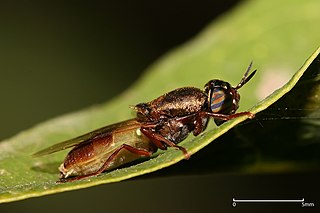
Odontomyia is a genus of soldier flies in the family Stratiomyidae. There are at least 220 described species in Odontomyia.

Scirtidae is a family of beetles (Coleoptera). These beetles are commonly referred to as marsh beetles, as the larvae are typically associated with stagnant water, but can be found in flowing water. Adults prefer decomposing plant material near the water's edge. More than an estimated 600 species are known worldwide, distributed among at least 60 genera.

The Ropalomeridae are a family of acalyptrate flies.

The Cryptochetidae are a small family of tiny flies. Some twenty to thirty species are known. Generally they are metallic blue black, stoutly built, with the head broad and high and with clear wings. Like other species in the superfamily Lonchaeoidea, the Cryptochetidae have antennae with a cleft in the second segment. Unlike practically all Schizophora however, they lack an arista, or if they do have one, it is too small to distinguish with any confidence. The family name refers to this unusual distinction; "Cryptochetidae" literally means "those with hidden bristles". The adult flies also are unusual among insects in that they have only a single pair of abdominal spiracles — this is not a serious physiological challenge in such small insects.
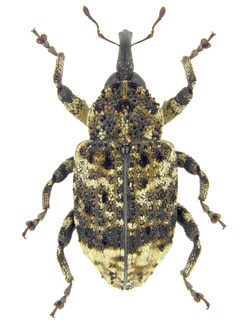
Cryptorhynchus is a genus of hidden snout weevils in the beetle family Curculionidae. There are at least 480 described species in Cryptorhynchus.
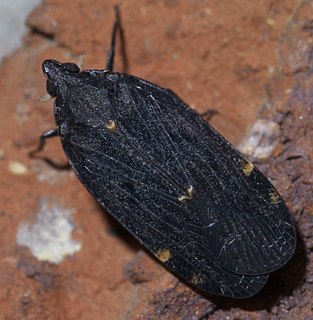
Achilidae is a family of achilid planthoppers in the order Hemiptera. There are at least 160 genera and 520 described species in Achilidae.
Tymnes chrysis is a species of leaf beetle. It is found in North America. The species has been recorded from plants of the genus Robinia or similar genera in the family Fabaceae.

Tymnes is a genus of leaf beetles in the subfamily Eumolpinae. It is known from North America and Central America. There are at least nine described species in Tymnes.
Tymnes oregonensis is a species of leaf beetle. It is found in North America.
Eupsenius is a genus of ant-loving beetles in the family Staphylinidae. There are about six described species in Eupsenius.
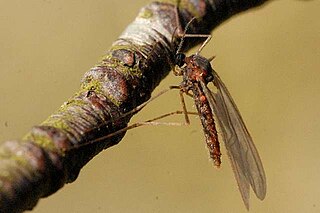
Mycomya is a genus of fungus gnats in the family Mycetophilidae. There are at least 400 described species in Mycomya.

Cionomimus insolens is a species of true weevil in the beetle family Curculionidae. It is found in North America.

Culex salinarius, the unbanded saltmarsh mosquito, is a species of mosquito in the family Culicidae.
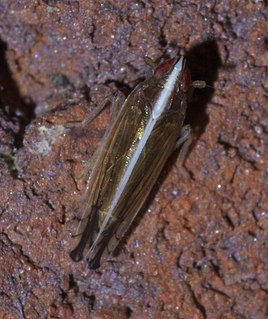
Stenocranus lautus is a species of delphacid planthopper in the family Delphacidae. It is found in the Caribbean and North America.
Tymnes tricolor is a species of leaf beetle. It is found in North America.















